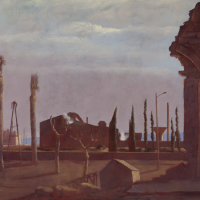79. RICK AMOR

In early 1991, Rick Amor was awarded a residency at the Visual Arts and Craft Boards studio in Barcelona. As a keen admirer of Pablo Picasso (1881-1973), Amor was thrilled to be visiting the city that had nourished the artistic hero of his youth, even citing Barcelonas Museo Picasso in his application. Amor spent his three-month sojourn producing sketches and watercolours that he would later develop into paintings upon his return to Australia. In his final report to the Australia Council, Amor remembers his daily routine in Barcelona with fondness:
The rhythm of life in Barcelona dictated my working procedure. I would go out in the morning, and make notes, sketches and watercolours, visit galleries and museums, have a siesta then in the evening work the sketches into more detailed pictures.1
The vibrant, sunlit city of Barcelona presented a predicament for Amor, whose artistic style is characterised by enigmatic scenery of moody Melbourne. In a letter on 6 August 1991 his wife, Meg Williams, wrote, Rick is struggling a bit to get [the city] onto paper without being picturesque. The result is a gloomier view than most Catalans would have of their sunny city.2 In an effort to avoid the typical snapshots of scenic Barcelona, Amor explored the citys grittier fringes. That is not to say that he avoided the picturesque altogether. Some of the paintings exhibited in the resultant 1992 Niagara Galleries exhibition, particularly the present work, are directly comparable to early European picturesque landscape paintings. Art critic Robert Rooney said of Outlying Districts, Barcelona: With its forwardly placed picturesque ruin and distant factory buildings [the painting] could pass for a 19th century artists vision of industrys first satanic intrusion into the landscape.3
The theory of the picturesque in landscape painting was developed in the late eighteenth century by William Gilpin (1724-1804), who referenced artists such as Claude Lorrain (1600-1682).4 It refers to an artistic ideal which combines the sublime (vistas of overwhelming grandeur and wildness that inspire both awe and fear) and the beautiful (that which is aesthetically pleasing). To continue Rooneys comparison, in Outlying Districts, Barcelona Amor combines the classical beauty of the crumbling ruin in the foreground with Barcelonas derelict industrial outskirts - a modern sublime landscape, its harshness and magnitude both impressive yet daunting. The result is in a sense a contemporary picturesque.
Amors work invariably has a strong architectural focus, making him an ideal candidate for a European residency. In a city famed for the idiosyncratic designs of Catalan architect Antoni Gaud (1852-1926), Amor focused instead on the reality of living in Barcelona, creating poignant, perfectly balanced compositions. Here, the curve of the brick archway is abruptly halted before reaching its peak, the bricks crumbling into vacant space. Smoke billows from the factory buildings while bedraggled pine and palm trees struggle to survive in this manufactured wasteland. Unusually for Amor, there is no human figure included to give the buildings scale a deliberate omission to highlight the inhospitable nature of these constructed environments.
While the palette remains characteristically subdued, the tones are much warmer than Amors chilly Victorian scenes. There is a subtle ochre colour beneath the surface, giving a sense of the warmth that the buildings retain from the Spanish sun, now hidden by a muggy cloud cover. A band of pale blue on the mostly obscured horizon suggests the Mediterranean Sea beyond, a northern hemisphere counterpart to Amors depictions of the docks at Port Phillip Bay.
Footnotes:
1. Catalano, G., The Solitary Watcher: Rick Amor and His Art, Melbourne University Press, Melbourne, 2001, p.123
2. Meg Williams to Helen Hewitt and Gary Catalano, 6 August 1991, quoted in Catalano, G., op. cit., p.124
3. Rooney, R., Theres No Criticism Like Self-criticism, The Weekend Australian, 1992, quoted in Catalano, G., op. cit., p.127
4. Gilpin, W., Observations on the River Wye, and Several Parts of South Wales, etc. Relative Chiefly to Picturesque Beauty; made in the Summer of the Year 1770, Richmond Blamire, London, 1789
Asta Cameron